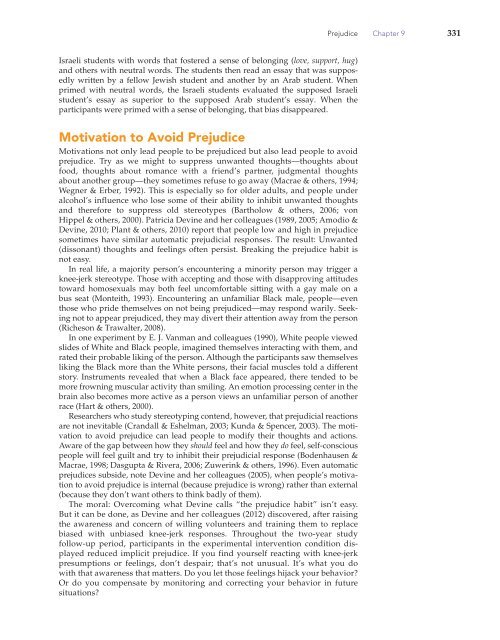Chapter 9: Prejudice: Disliking Others (2947.0K) - Bad Request
Chapter 9: Prejudice: Disliking Others (2947.0K) - Bad Request
Chapter 9: Prejudice: Disliking Others (2947.0K) - Bad Request
Create successful ePaper yourself
Turn your PDF publications into a flip-book with our unique Google optimized e-Paper software.
Israeli students with words that fostered a sense of belonging ( love, support, hug )<br />
and others with neutral words. The students then read an essay that was supposedly<br />
written by a fellow Jewish student and another by an Arab student. When<br />
primed with neutral words, the Israeli students evaluated the supposed Israeli<br />
student’s essay as superior to the supposed Arab student’s essay. When the<br />
participants were primed with a sense of belonging, that bias disappeared.<br />
Motivation to Avoid <strong>Prejudice</strong><br />
Motivations not only lead people to be prejudiced but also lead people to avoid<br />
prejudice. Try as we might to suppress unwanted thoughts—thoughts about<br />
food, thoughts about romance with a friend’s partner, judgmental thoughts<br />
about another group—they sometimes refuse to go away (Macrae & others, 1994;<br />
Wegner & Erber, 1992). This is especially so for older adults, and people under<br />
alcohol’s influence who lose some of their ability to inhibit unwanted thoughts<br />
and therefore to suppress old stereotypes (Bartholow & others, 2006; von<br />
Hippel & others, 2000). Patricia Devine and her colleagues (1989, 2005; Amodio &<br />
Devine, 2010; Plant & others, 2010) report that people low and high in prejudice<br />
sometimes have similar automatic prejudicial responses. The result: Unwanted<br />
(dissonant) thoughts and feelings often persist. Breaking the prejudice habit is<br />
not easy.<br />
In real life, a majority person’s encountering a minority person may trigger a<br />
knee-jerk stereotype. Those with accepting and those with disapproving attitudes<br />
toward homosexuals may both feel uncomfortable sitting with a gay male on a<br />
bus seat (Monteith, 1993). Encountering an unfamiliar Black male, people—even<br />
those who pride themselves on not being prejudiced—may respond warily. Seeking<br />
not to appear prejudiced, they may divert their attention away from the person<br />
(Richeson & Trawalter, 2008).<br />
In one experiment by E. J. Vanman and colleagues (1990), White people viewed<br />
slides of White and Black people, imagined themselves interacting with them, and<br />
rated their probable liking of the person. Although the participants saw themselves<br />
liking the Black more than the White persons, their facial muscles told a different<br />
story. Instruments revealed that when a Black face appeared, there tended to be<br />
more frowning muscular activity than smiling. An emotion processing center in the<br />
brain also becomes more active as a person views an unfamiliar person of another<br />
race (Hart & others, 2000).<br />
Researchers who study stereotyping contend, however, that prejudicial reactions<br />
are not inevitable (Crandall & Eshelman, 2003; Kunda & Spencer, 2003). The motivation<br />
to avoid prejudice can lead people to modify their thoughts and actions.<br />
Aware of the gap between how they should feel and how they do feel, self-conscious<br />
people will feel guilt and try to inhibit their prejudicial response (Bodenhausen &<br />
Macrae, 1998; Dasgupta & Rivera, 2006; Zuwerink & others, 1996). Even automatic<br />
prejudices subside, note Devine and her colleagues (2005), when people’s motivation<br />
to avoid prejudice is internal (because prejudice is wrong) rather than external<br />
(because they don’t want others to think badly of them).<br />
The moral: Overcoming what Devine calls “the prejudice habit” isn’t easy.<br />
But it can be done, as Devine and her colleagues (2012) discovered, after raising<br />
the awareness and concern of willing volunteers and training them to replace<br />
biased with unbiased knee-jerk responses. Throughout the two-year study<br />
follow-up period, participants in the experimental intervention condition displayed<br />
reduced implicit prejudice. If you find yourself reacting with knee-jerk<br />
presumptions or feelings, don’t despair; that’s not unusual. It’s what you do<br />
with that awareness that matters. Do you let those feelings hijack your behavior?<br />
Or do you compensate by monitoring and correcting your behavior in future<br />
situations?<br />
<strong>Prejudice</strong> <strong>Chapter</strong> 9 331

















